Speech Financial Stability Through the Lens of Business

Michele Bullock[*]
Assistant Governor (Financial System)
Address to the Toowoomba Chamber of Commerce
Toowoomba –
- Audio 20.29MB
- Q&A Transcript
- Download 1MB
Thank you to the Toowoomba Chamber of Commerce for inviting me to speak with you today. It is a pleasure to be here.
I have spoken about financial stability from a number of perspectives in the past – resilience of the banking sector, developments in the property sector and developments in the household sector. Today I want to talk about financial stability from the perspective of the business sector. In our regular Financial Stability Review, we always discuss the corporate sector balance sheet and its resilience. Today I want to draw out some of the issues we have been focusing on in recent months.
But, first of all, what is financial stability and why is it important? As I have said in the past, there is no universal definition. But basically, it is when the financial sector is doing its job of facilitating a smooth flow of funds in the economy to support economic growth. The opposite, financial instability, is probably easier to picture though. This is where the financial sector is experiencing disruptions so that it harms the economy. The global financial crisis, or GFC, was a very vivid demonstration of what can happen when the financial system is unstable – credit supply dries up, investment and consumption fall and unemployment rises. So there is a very human cost to financial instability.
While we at the Reserve Bank do not have responsibility for the supervision of financial institutions, we do have an important role in monitoring the financial system as a whole and the economy for financial imbalances that could lead to instability. We typically look at such things as developments in financial markets, and, in particular, evidence of excessive risk-taking behaviour, the balance sheets of financial institutions and their resilience to changes in economic circumstances, and household and business balance sheets. Part of our role is to draw attention to potential risks that might be building and have an impact on the stability of the financial system.
Why are developments in the business sector relevant for financial stability? One obvious link is that if businesses are struggling to meet their obligations, they impact on the real economy and this could have flow-on effects to bank balance sheets through increasing non-performing loans and defaults. But poorly performing businesses in one sector could also feed through to employment and businesses in other sectors, amplifying the effect. For example, poorly performing retail businesses might impact workers as well as owners and developers of shopping centres. Farm businesses that are affected by the drought will reduce their expenditure on capital and labour as well as their expenditure on discretionary consumption, impacting a range of businesses in their communities. And these impacts in turn will be reflected in banks' asset quality if households and businesses find it more difficult to service their loans. Furthermore, while specific shocks to a particular business sector may not have immediate financial stability implications, they can mean that businesses in that sector are, for some time, more vulnerable to broader macroeconomic shocks. So it is important for us to understand and assess the impact of idiosyncratic shocks on balance sheet health.
In addition, some developments can be quite specific to business conditions in particular regions, and to those financial institutions that have extended credit to businesses and households in those regions. The end of the mining investment boom, for example, had significant implications for the economy and businesses in mining intensive regions, such as Western Australia and parts of Queensland. This in turn has seen large falls in housing prices and increases in arrears in these regions. However, banks appear to be managing this, and the increase in arrears does not currently pose a risk to financial stability. Nonetheless, it does illustrate that in assessing the financial stability implications of business conditions, it is important to give some consideration to sectors, regions, and even the size of the firms.
In the rest of my speech, I will discuss some aspects of business conditions that are relevant to thinking about financial stability. I will start with some information on businesses in aggregate. I will then talk a little about some individual sectors and I will finish up with a focus on the small business sector.
Conditions in the business sector
There are a number of metrics we use to look at the financial health of firms.
- Profitability or return on equity give an indication of the general health of the business. Firms with low profitability are more likely to cease operations due to poor performance and, in the process, potentially default on their debts.
- Gearing looks at how much debt relative to equity there is in the business. Firms with high gearing are more vulnerable to asset price falls and losses from their operations as they have a relatively small equity buffer. This makes them more likely to go bankrupt and default. So, if gearing is high, the firm is likely to be viewed as riskier.
- Debt-servicing ratios measure the ratio of interest expenses on any debt to the profits of the business. This gives an indication of firms' capacity to repay their loans. The higher this is, the more at risk firms are if interest rates rise or profits fall.
- Liquidity measures the ratio of cash to a firm's current liabilities. This measures the firm's ability to repay its current liabilities as they become due. If this is very low, firms are at risk of being unable to meet their short-term financial obligations.
The most current data we have on the financial position of businesses is from listed corporations. Companies listed on the stock exchange tend to be large, and have to report regular information to the market. This provides a useful source of timely information on companies' financial health. In contrast, small businesses are unlisted and so information about their financial health is less readily available and comes with a longer lag. Because they account for the majority of borrowing, large businesses pose a greater risk to financial stability. That's not to say small businesses aren't important, and I will come back to discuss them later.
On the basis of listed companies reporting, conditions in the business sector in 2018 were positive overall, supported by continued economic growth and low interest rates.
In aggregate, profits of listed non-financial corporations have looked healthy over recent years. The aggregate return on equity (before interest, tax and depreciation) of these firms was around 25 per cent in 2018, a little higher than it has been on average since the GFC (Graph 1). Gearing and debt-servicing ratios have trended lower in recent years and liquidity has increased further. This means that, in aggregate, firms have a larger equity buffer in their business, are less vulnerable to unexpected decreases in cash flows and are better placed to repay their short-term financial obligations. This is good from the perspective of financial stability as firms seem to be less vulnerable to negative economic shocks.
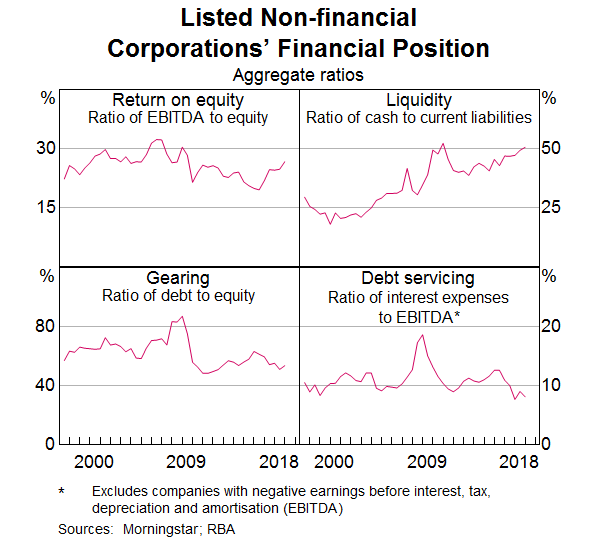
But the aggregates can disguise substantial differences across firms. It is therefore important to look at the distribution of the various financial metrics. For this purpose we typically look at the median and the risky ‘tails’ of the distribution. The median is the value of the metric which is in the middle of the group – half the group have values above the median and half have values below. There are a number of ways to define the risky tail of the distribution. Today, I am defining it as either the top or bottom 25 per cent depending on the relationship between the financial metric and firm riskiness. For example, higher gearing and debt-servicing ratios make a firm more vulnerable to negative shocks. So we examine more carefully those firms for whom gearing and debt-servicing burden fall in the top 25 per cent of the group. On the other hand, low profitability and liquidity tend to make firms more vulnerable. Consequently, we look at developments in the group of firms with ratios in the bottom 25 per cent of the distribution.
Looking at the distributions of the financial metrics, the financial position of the most vulnerable firms generally improved over the past few years (Graph 2). While the least profitable 25 per cent of companies are making losses, returns on equity for this group have risen slightly over the past few years. These companies, however, tend to have very little debt overall so there is little potential for flow-on effects to the financial sector. Gearing ratios for firms in the top 25 per cent of the group are quite a bit lower than they were a decade ago. In line with low gearing and the low interest rate environment, the debt-servicing ratios for companies in the top 25 per cent of the distribution are also at low levels, having fallen sharply over the past decade. Lastly, the liquidity position of companies in the bottom 25 per cent has been reasonably stable over the past few years at higher levels than seen in the years leading up to the financial crisis. In general, it would seem that the financial stability risks from these vulnerable firms are not increasing.
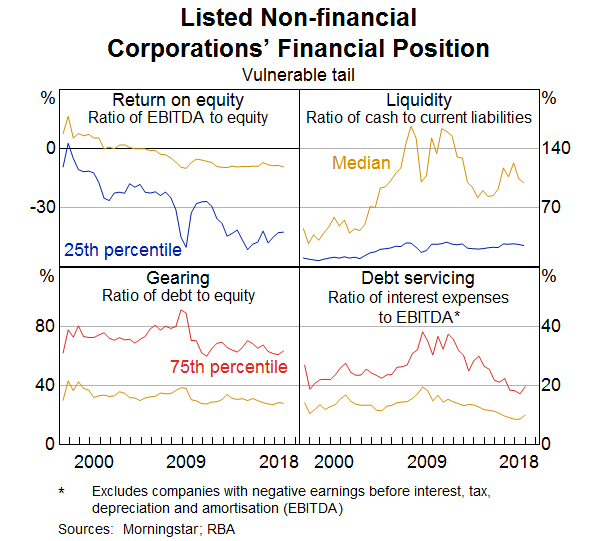
Sectoral differences
Another perspective on financial stability risks comes from looking at sectors facing changes in their environment that could make them more vulnerable. The two I am going to focus on here are domestic retailing and mining because they provide some interesting contrasts.
Domestic retailing, particularly bricks-and-mortar retailing for discretionary goods, has been experiencing challenging conditions in recent years. Competition from both large international and online retailers has been intense; consumer spending is growing slowly and consumer preferences are changing.
Some colleagues of mine undertook some work on the potential financial stability risks associated with the retailing sector in the second half of last year.[1] Broadly, they concluded that, although retailers and investors face a number of risks, there is currently no strong evidence of widespread vulnerability, or that risks to banks are high.
They found that while listed discretionary goods retailers appear to be in good financial health overall, there were some signs of financial difficulties in some unlisted and smaller retailers. The next two graphs, drawn from their work, show some key financial ratios for listed and unlisted retailers respectively. There is a lot of information here so I want to draw your attention to just a few points. Starting with the listed sector, the financial position of discretionary retailers generally appear sound (Graph 3). Profitability as measured by return on equity has remained broadly stable at reasonably high levels across the distribution. Similarly, liquidity ratios are also at reasonably high levels so companies appear well positioned to meet their short-term liabilities. Turning to the bottom panels of the graph, gearing has been broadly unchanged at low levels across the distribution. In line with this, and also reflecting declining interest rates, debt-servicing ratios have trended downwards to be fairly low.
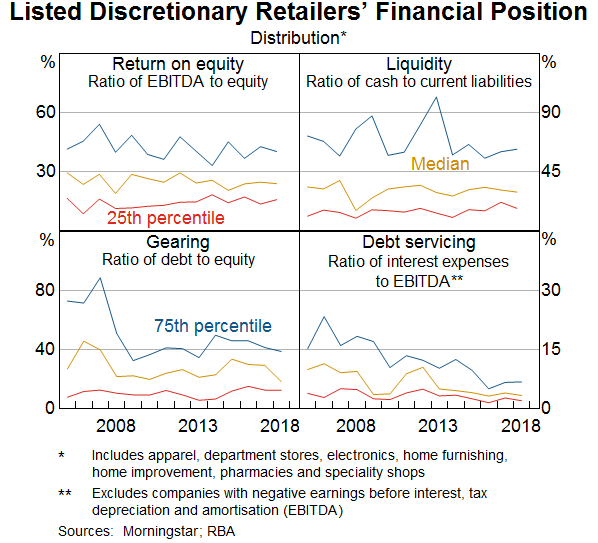
Unlisted retailers, on the other hand, are not so well positioned in terms of gearing and liquidity (Graph 4). Over one quarter of unlisted retailers are highly indebted, with gearing ratios above 100 per cent. This implies that their debt is larger than their equity and, as a result, they are more vulnerable to asset devaluations or losses. In addition, liquidity ratios declined in recent years and remain at low levels. This in turn has increased the risk that they will not be able to meet their short-term liabilities without selling assets. Another negative development in this sector is that the share of loss-making retailers has increased over the past few years. However, these retailers are, on average, smaller, accounting for around 10 per cent of total retail sector debt.
Similarly, they found that, looking across listed and unlisted companies, small retailers are more likely to be identified as vulnerable than large retailers.[2] This classification is based on whether at least two out of the four financial ratios fall in the most vulnerable 25 per cent of their distributions. Basing this classification on at least two ratios is important because looking at one financial metric alone may not give us a true sense of the firm's financial health. For example, a firm may have a relatively high gearing ratio but may be able to safely sustain this due to strong profitability. Taken together, smaller retailers appear to be facing more difficult conditions in both the listed and unlisted sector. Having said that, there is no current evidence of widespread vulnerability and difficulties in the sector appear unlikely to pose a significant risk to the banking sector.
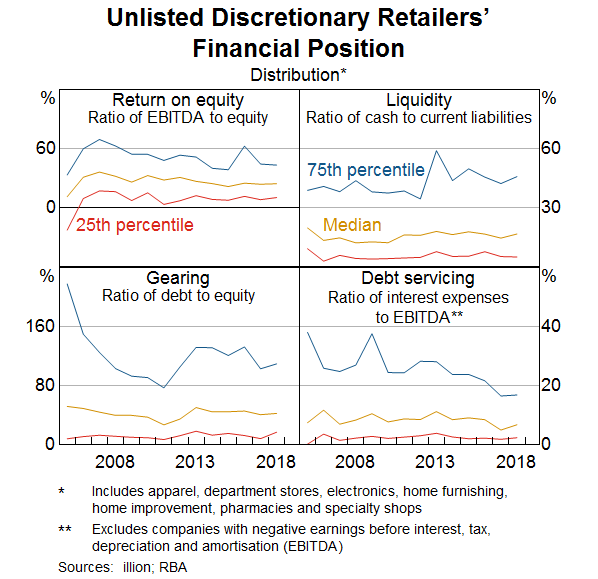
However, the challenges faced by brick-and-mortar retailers have spilled over into the demand for retail floor space. Conditions are weakest in mid-sized shopping centres, where vacancy rates have increased to around 5 per cent, up from around 3 per cent a few years ago (Graph 5). Vacancy rates have also drifted a little higher in large shopping centres. Rents have been flat over the past few years, and landlords have attempted to avoid vacancies by increasing incentives and changing tenancy mixes. And retail valuations have been rising much slower than other commercial property valuations. At the same time, there has been a considerable increase in retail development activity in recent years, both in terms of refurbishments and the building of new centres. It is possible that some of this might just be keeping pace with population growth. But there is also a risk that new and improved shopping centres simply cannibalise business from some other centres, eventually resulting in excess supply, particularly in light of weak household spending of late. This would weigh on rents and valuations. And, to the extent that owners of these centres hold debt, difficulties in servicing repayments could result in further sales and price declines.
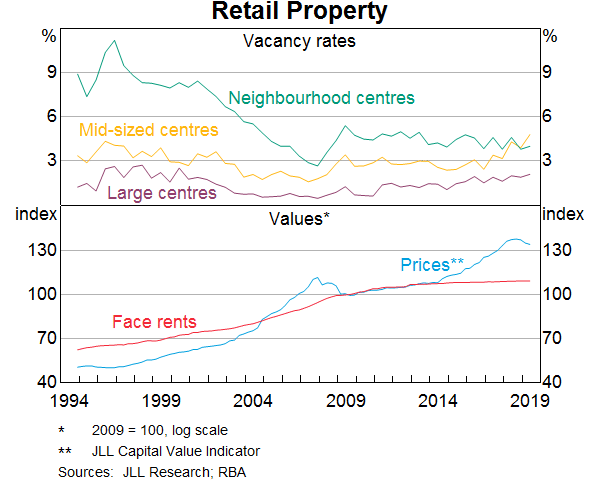
Ultimately, the implication for financial stability of these vulnerabilities depends on the exposures of the financial institutions to retail businesses and developers. So the third issue addressed by my colleagues was banks' exposures to retail commercial property development. Given the increase in retail property development over the past decade, it is perhaps not surprising to see that banks' exposures have also risen (Graph 6). Indeed, in terms of commercial property, banks are most exposed to office and retail, and exposures to both these sectors have increased sharply over the past decade. Nevertheless, at less than $60 billion, the exposure represents less than 3 per cent of major banks' assets. And despite the difficult conditions in this sector, this has not translated into a deterioration in loan performance with non-performing loans to the retail sector remaining unchanged at low levels. So, while there may be vulnerabilities in the retail sector, these do not currently seem to pose a significant risk to the financial sector.
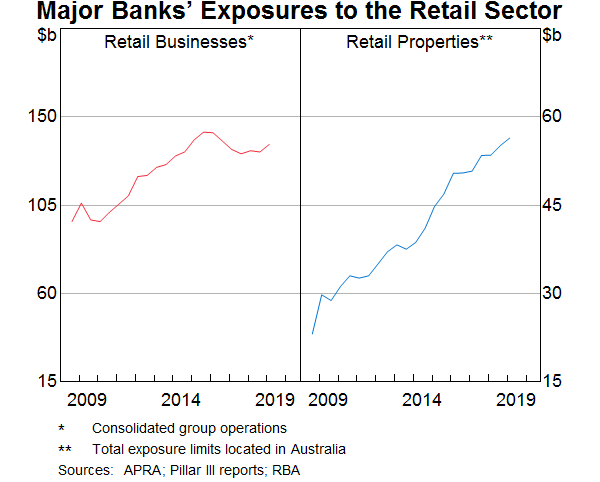
The second sector I want to focus on is the mining sector. In contrast to the retail sector, mining firms in aggregate have experienced improved conditions recently, driven by increased commodity prices. Accordingly, profitability has increased to be at its highest level in the past ten years (Graph 7). Liquidity is also at a very high level. At the same time, debt and gearing ratios are at the lower end of the ranges seen over the past couple of decades. In fact, they are also relatively low when compared to firms outside of the resources sector. As a result, mining firms' balance sheets appear well placed to absorb shocks, perhaps more than has been the case for some time. So, while risks related to market conditions have abated somewhat, this has occurred alongside ongoing improvements in mining firms' balance sheet positions. Specifically, firms in the sector have reported a strong focus on reducing costs, realising efficiencies and paying down debt, particularly amid earlier expectations of commodity price declines (as global supply increased and demand was seen to be moderating). And while banks' direct exposures to the mining sector tend to be very low at around one per cent, the mining sector accounts for around 20 per cent of Australia's business investment. As such, there are important spillover channels to the rest of the economy, which mean that the improved position of mining firms reduces risks to firms in other parts of the economy.
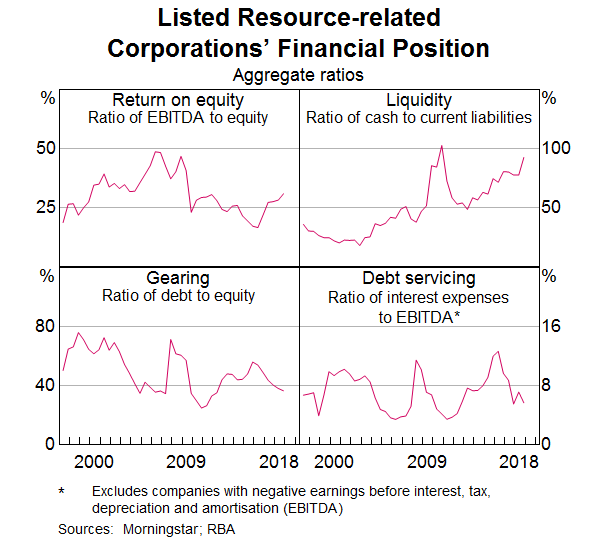
Small business
The final issue I want to briefly cover is conditions for small business more generally and risks that could arise from this source. Small businesses are a substantial part of the Australian economy.[3] They account for 70 per cent of employment and 40 per cent of production in the private non-financial sector. Difficult conditions in small business could therefore have flow-on effects to the economy through decreasing employment and lower income for unincorporated enterprises, and hence to the health of households' balance sheets more broadly. And these effects are often particularly felt in regional areas where small businesses are part of the lifeblood of the community. Furthermore, there could be impacts on banks' asset quality if non-performing loans rise.
Small businesses have been facing tighter credit conditions over the past year or so from a level that was already tight. Over the past couple of years, lending to small businesses (which includes businesses with annual turnover of less than $50 million) has hardly grown at all, unlike lending to large businesses, which has grown by around five per cent per year on average (Graph 8).
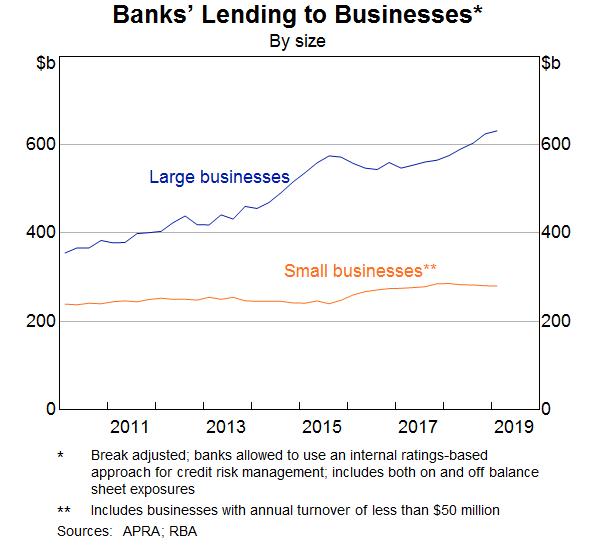
There are a number of reasons why small businesses are facing tighter credit conditions.[4] First, there is a more of a blurring in the line between lending to small business and personal credit. The obligations placed on financial institutions for lending to consumers (under responsible lending obligations) are stricter than the requirements for lending to small business, and these have tightened over the past couple of years. But lenders are increasingly treating small businesses as household borrowers, imposing the stricter conditions on small business lending. Furthermore, property is a common form of security for small business lending – around 50 per cent of loans to small business are secured by residential property. The decline in housing prices over the past couple of years has therefore likely to have reduced the amount of money that small businesses can borrow.
Having said that, some colleagues of mine have done some work looking at the characteristics of firms that are likely to receive credit.[5] They showed that, while the size of the business is an important consideration in the lender's decision to extend credit, other factors are also important once you control for size and other characteristics. These other factors include profitability, debt-servicing ratios and credit history. For example, more profitable firms are more likely to receive credit after controlling for the influence of other characteristics.
Nonetheless, tighter credit conditions make it more difficult for small businesses to fund themselves or to refinance existing debt. It is likely to be particularly challenging in regional areas impacted by the drought, where many businesses are already experiencing difficulties.
It is possible that these tighter credit conditions might push small businesses into failure and default on their loans. But any impact from this channel on the financial system at this stage is still quite small. Non-performing loans in the private unincorporated business sector have risen a bit over the past year or so but they remain at relatively low levels (Graph 9). And lending to this sector accounts for a small share of banks' assets.
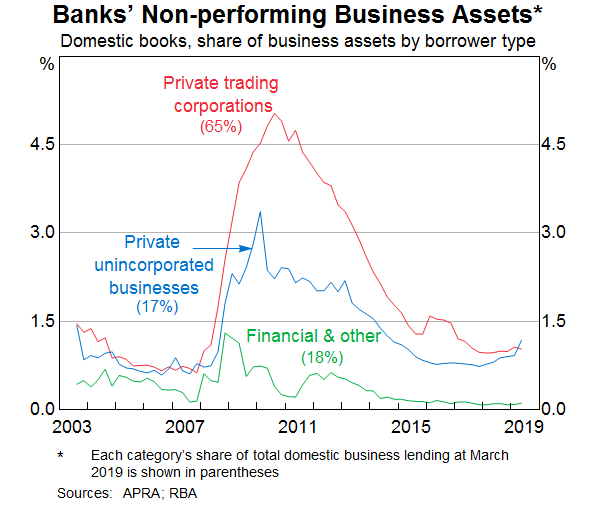
Conclusion
Today I have outlined a view of the stability of the Australian financial system through the lens of the business sector. In general, the financial health of businesses looks sound. And while some individual sectors and regions do face challenges, these do not currently pose a threat to financial stability. Financial institutions are resilient and their exposures to these areas remain low. It is nevertheless important to keep an eye on developments in the business sector and remain alert to possible risks to financial stability from this source.
Endnotes
I am grateful to Gabriela Araujo and Cathie Close for assistance with this speech. [*]
Araujo G and T De Atholia (2018), ‘Financial Stability Risks and Retailing’, RBA Bulletin, September. [1]
They define small businesses as those with less than $10 million in assets, medium-sized businesses as those with more than $10 million but less than $100 million in assets, and large businesses as those with $100 million or more in assets. [2]
There are a variety of definitions of small business. The definition here is businesses with annual turnover less than $50 million. [3]
Connolly E and J Bank (2018), ‘Access to Small Business Finance’, RBA Bulletin, September. [4]
Araujo G and J Hambur (2018), ‘Which Firms Get Credit? Evidence from Firm-level Data’, RBA Bulletin, December. [5]